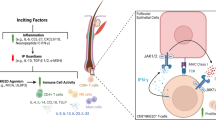Summary
H-Y antigen could not be detected on lymphocytes from two male pseudohermaphrodites with 46,XY karyotypes and testicular tissue. One of the patients had additional assays performed on fibroblasts grown from the skin, and the gonadal ridge—these were also negative. The H-Y antiserum was raised in rats, with Raji cells the target of cytotoxicity tests. In these patients, the substance that promoted testicular differentiation does not have serologic H-Y antigen detectable by the assay used. It appears that H-Y antigen that is commonly measured in neutralization reactions may not be the only form of testicular organizing factor present.
Similar content being viewed by others
References
Celada F, Wilsons WJ (1963) An immunogenetic analysis of the male antigen in mice utilizing animals with an exceptional chromosome constitution. Genetics 48:139–151
Donahoe PK, Crawford JD, Hendren WH (1979) Mixed gonadal dysgenesis, pathogenesis, and management. J Pediatr Surg 14:287–300
Eichwald EJ, Silmser CR (1955) Untitled communication. Transp Bull 2:148–149
Fellous M, Gunther E, Kemler R, Wiels J, Berger R, Guenet JL, Jakob H, Jacob F (1978) Association of the H-Y male antigen with β2-microglobulin on human lymphoid and differentiated mouse teratocarcinoma cell lines. J Exp Med 147:58–70
Ford CE, Evans EP, Burtenshaw MD, Clegg HM, Tuffrey M, Barnes RD (1975) A functional ‘sex-reversed” oocyte in the mouse. Proc R Soc Lond [Biol] 190:187–197
Goldberg E, Boyse EA, Bennett D, Scheid M, Carswell EA (1971) Serological demonstration of H-Y (male) antigen on mouse sperm. Nature 232:478–480
Gordon J (1978) Use of the sex reversed gene (Sxr) to investigate functional sex reversal and gonadal determination in mammals. In: Russel LB (ed) Genetic mosaics and chimeras in mammals, p 143–163
Haseltine FP, Breg WR, Koo GC, Wachtel SS, Genel M (1980) H-Y antigen expression in subjects with Turner's phenotype and i(Xq). Abstract. Society for Genecologic Investigation 223
Haseltine FP, Ohno S (1981) Mechanisms of sex differentiation. Science 211:1272–1278
Krco CJ, Goldberg EH (1976) Detection of H-Y (male) antigen on 8-cell mouse embryos. Science 193:1134–1135
Mintz B (1968) Hermaphroditism, sex chromosomal mosaicism, and germ cell selection in allophenic mice. J Anim Sci (Suppl. 1), 27:51
Muller U, Wolf U, Siebers JW, Gunther E (1979) Evidence for a gonadspecific receptor for H-Y antigen: Binding of exogeneous H-Y antigen to gonadal cell is independent of β2. Cell 17:331–335
Nagai Y, Cicarese S, Ohno S (1979) The identification of human H-Y antigen and testicular transformation induced by its interaction with the receptor site of bovine fetal ovarian cells. Differentiation 13:155–164
Ohno S, Nagai Y, Cicarese S (1979) Testis-organizing H-Y antigen and the primary sex-determining mechanism of mammals. Recent Prog Horm Res 35:449–470
Puck SM, Haseltine FP, Franckell (1981) Absence of H-Y antigen in a 46,XY female with campomelic dysplasia. Hum Genet (in press)
Rary JM, Cummings DK, Jones HW Jr, Rock JA (1979) Assignment of the H-Y antigen gene to the short arm of chromosome Y. J Hered 70:78–80
Wachtel SS, Hall JL (1979) H-Y binding in the gonad: Inhibition by a supermatant of the fetal ovary. Cell 17:327–329
Wachtel SS, Koo GC, Breg WR, Genel M (1980) H-Y antigen in X,i(Xq) gonadal dysgenesis; evidence of X-linked genes in testicular differentiation. Hum Genet 56:183–187
Wolf U (1978) Zum Mechanismus der Gonadendifferenzierung. Bull Schweiz Akad Med Wiss 34:357–368
Wolf U, Fraccaro M, Mayerova A, Hecht T, Zuffardi O, Hameister H (1980) Turner syndrome patients are H-Y positive. Hum Genet 54:315–318
Zenzes MT, Wolf U, Gunther E, Engel W (1978a) Studies on the function of H-Y antigen: Dissociation and reorganization experiments on rat gonadal tissue. Cytogenet Cell Genet 20:365–372
Zenzes MT, Muller U, Aschmoneit I, Wolf U (1978b) Studies on H-Y antigen in different cell fractions of the testis during pubescence: Immature germ cells are H-Y antigen negative. Hum Genet 45: 297–303
Author information
Authors and Affiliations
Rights and permissions
About this article
Cite this article
Haseltine, F.P., Genel, M., Crawford, J.D. et al. H-Y antigen negative patients with testicular tissue and 46,XY karyotype. Hum Genet 57, 265–268 (1981). https://doi.org/10.1007/BF00278941
Received:
Revised:
Issue Date:
DOI: https://doi.org/10.1007/BF00278941




